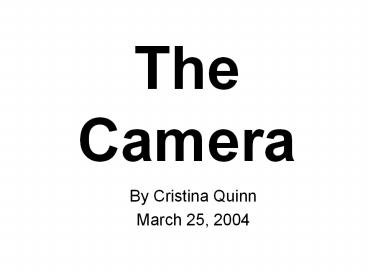By Cristina Quinn - PowerPoint PPT Presentation
1 / 9
Title:
By Cristina Quinn
Description:
http://entertainment.howstuffworks.com/camera.htm/printable.. http://science.howstuffworks.com/question51.htm. http://travel.howstuffworks.com/autofocus.htm ... – PowerPoint PPT presentation
Number of Views:53
Avg rating:3.0/5.0
Title: By Cristina Quinn
1
The Camera
- By Cristina Quinn
- March 25, 2004
2
Introduction
- There are two types of film cameras on the
market Single Lens Reflex (SLR) cameras and
point and shoot cameras. - The main difference is the mechanics of the
viewfinder. - In point and shoot cameras, the viewfinder is
simply a window that gives an idea of what is in
view. - SLR camera viewfinders allow for the actual
image, as seen by the film, to be viewed. - This is accomplished by using a slanted mirror in
front of the shutter and a prism to invert the
image to its proper orientation.
- When the shutter button is pressed, the mirror
flips out of the way so that the image is
directed onto the film.
3
Light Control
- The amount of light exposed to the film is
controlled by both how much light passes through
the lens and how long the film is exposed. - The iris diaphragm opens and closes to control
the diameter of the lens. - The shutter controls the light flow by the amount
of time it remains open. - Most SLR cameras have a focal plane shutter.
- The length of time which the shutter remains open
can also be adjusted to capture fast motion.
The Iris Diaphragm
The focal plane shutter.
4
Image Size
- The farther away the object is from the lens the
smaller the image will be. - The shape of the lens also affects the size of
the image. - A lens with a rounder shape will curve the light
more and form an image closer to the lens. - A flatter shaped lens will not bend the light as
much and the image will form farther away. - Increasing the distance between the lens and the
real image will increase the size of the image.
5
Focus
- The distance of the object from the lens will
affect the focal length. i.e. The closer the
object, the farther away the image will form. - If the image is not formed on the film, the image
will appear blurry. - To focus a lens, it is moved either closer or
farther away from the film surface.
6
Autofocus
- The two types of autofocus systems are active
and passive - More expensive cameras with interchangeable
lenses use the passive system while less
expensive cameras use an active system. - Active systems
- These systems project infrared pulses towards the
subject and measure its distance from the lens by
either triangulation (angle of reflection), time,
or the amount of IR light reflected from the
subject. - Problems associated with IR sensing
- Other sources of IR light can confuse sensor
(i.e. candle flame, fire) - A black surface will absorb the reflecting IR
beam. - The IR beam may reflect off an object other than
the subject of interest (i.e. a window). - This system can be used regardless of lighting.
7
Passive Autofocus
- Passive autofocus systems use computer analysis
of the image contrast to determine the distance. - A charge coupled device (CCD) is often the sensor
used which contains 100-200 pixels. - The microprocessor moves the lens and obtains
information from the CCD in search of the
distance which has the maximum intensity
difference between the pixels. - This system can be used to focus on an object
behind glass but requires light and some degree
of detail.
8
Interesting Features
- Camera zoom lenses contain several lenses in a
single unit. These lenses correct for chromatic
aberration i.e. different colours of light bend
differently and therefore do not line up
correctly. By changing the distances between
these lenses, the overall magnification can be
adjusted. - f-number a pinhole of light from the focal
length of the lens is projected from the lens as
a collimated beam. The f-number is equal to the
focal length of the beam divided by diameter of
the beam. - Many cameras have a "red eye reduction" feature.
Red eye occurs when light reflects off of the
blood vessels at the back of the retina. Cameras
which reduce the effects of red eye do so by
having the flash go off twice. The first flash
functions to stimulate the pupils to contract.
The second flash occurs when the picture is
actually taken. - Automatic cameras are controlled by a central
microprocessor rather than the user. It receives
information from the autofocus system and the
light meter and then adjusts the lens and
aperture accordingly.
9
References
- GoldBerg, Norman. Camera Technology The Dark
Side of the Lens. Academic Press, Inc., San
Diego, 1992. - http//entertainment.howstuffworks.com/camera.htm/
printable.. - http//science.howstuffworks.com/question51.htm.
- http//travel.howstuffworks.com/autofocus.htm
- The Camera. Time Life Books, 1981.































